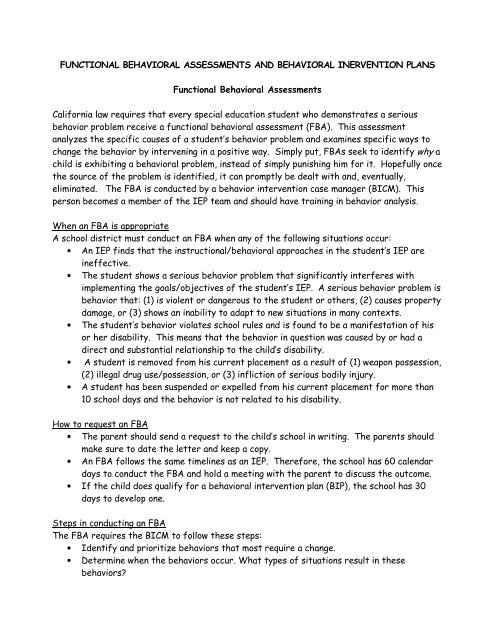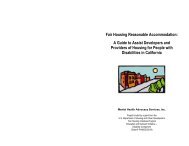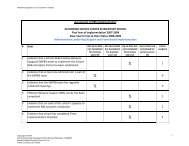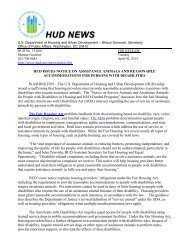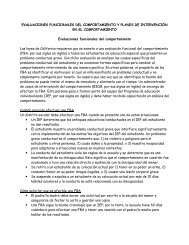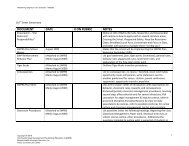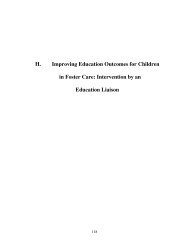FUNCTIONAL BEHAVIORAL ASSESSMENTS AND BEHAVIORAL ...
FUNCTIONAL BEHAVIORAL ASSESSMENTS AND BEHAVIORAL ...
FUNCTIONAL BEHAVIORAL ASSESSMENTS AND BEHAVIORAL ...
You also want an ePaper? Increase the reach of your titles
YUMPU automatically turns print PDFs into web optimized ePapers that Google loves.
<strong>FUNCTIONAL</strong> <strong>BEHAVIORAL</strong> <strong>ASSESSMENTS</strong> <strong>AND</strong> <strong>BEHAVIORAL</strong> INERVENTION PLANS<br />
Functional Behavioral Assessments<br />
California law requires that every special education student who demonstrates a serious<br />
behavior problem receive a functional behavioral assessment (FBA). This assessment<br />
analyzes the specific causes of a student’s behavior problem and examines specific ways to<br />
change the behavior by intervening in a positive way. Simply put, FBAs seek to identify why a<br />
child is exhibiting a behavioral problem, instead of simply punishing him for it. Hopefully once<br />
the source of the problem is identified, it can promptly be dealt with and, eventually,<br />
eliminated. The FBA is conducted by a behavior intervention case manager (BICM). This<br />
person becomes a member of the IEP team and should have training in behavior analysis.<br />
When an FBA is appropriate<br />
A school district must conduct an FBA when any of the following situations occur:<br />
• An IEP finds that the instructional/behavioral approaches in the student’s IEP are<br />
ineffective.<br />
• The student shows a serious behavior problem that significantly interferes with<br />
implementing the goals/objectives of the student’s IEP. A serious behavior problem is<br />
behavior that: (1) is violent or dangerous to the student or others, (2) causes property<br />
damage, or (3) shows an inability to adapt to new situations in many contexts.<br />
• The student’s behavior violates school rules and is found to be a manifestation of his<br />
or her disability. This means that the behavior in question was caused by or had a<br />
direct and substantial relationship to the child’s disability.<br />
• A student is removed from his current placement as a result of (1) weapon possession,<br />
(2) illegal drug use/possession, or (3) infliction of serious bodily injury.<br />
• A student has been suspended or expelled from his current placement for more than<br />
10 school days and the behavior is not related to his disability.<br />
How to request an FBA<br />
• The parent should send a request to the child’s school in writing. The parents should<br />
make sure to date the letter and keep a copy.<br />
• An FBA follows the same timelines as an IEP. Therefore, the school has 60 calendar<br />
days to conduct the FBA and hold a meeting with the parent to discuss the outcome.<br />
• If the child does qualify for a behavioral intervention plan (BIP), the school has 30<br />
days to develop one.<br />
Steps in conducting an FBA<br />
The FBA requires the BICM to follow these steps:<br />
• Identify and prioritize behaviors that most require a change.<br />
• Determine when the behaviors occur. What types of situations result in these<br />
behaviors?
• Examine the child’s records: both medical and educational.<br />
• Develop a hypothesis as to why the behaviors occur.<br />
• Identify alternative behaviors the child can use in place of the problematic behaviors.<br />
After the FBA is complete, there is an IEP meeting to review the results of the assessment<br />
and, if necessary, develop a behavioral intervention plan.<br />
The BICM will evaluate the success of the intervention on an ongoing basis. If it is<br />
unsuccessful, the BICM can change it as needed until a successful intervention is found.<br />
Behavioral Intervention Plans<br />
A BIP summarizes the FBA and describes the child’s problem behaviors, offers positive<br />
replacement behaviors, sets goals and objectives and sets out positive behavioral<br />
interventions and when they will be used.<br />
Examples of information included on a BIP are:<br />
• Skills training to increase appropriate behavior;<br />
• Changes that will be made in the classrooms or other environments to reduce or<br />
eliminate problem behaviors (e.g., providing choice, changing the setting, offering a<br />
meaningful curriculum, or establishing a predictable routine);<br />
• Strategies to replace problem behaviors with appropriate behaviors that serve the<br />
same function for the child-that is the appropriate behavior produces the same result<br />
as the inappropriate behavior;<br />
• Incentives to encourage the child to use the appropriate behavior;<br />
• Teaching the child adaptive behaviors such as self-management and relaxation<br />
techniques; and<br />
• Positive reinforcements of alternative and other acceptable behaviors and redirection<br />
of unacceptable behaviors.<br />
When a child continues to exhibit the problematic behavior, the BIP may suggest that the<br />
teacher:<br />
• ignore the behavior, but not the individual;<br />
• redirect the child verbally and/or physically to another activity;<br />
• provide the student with feedback;<br />
• acknowledge the message of the behavior; and<br />
• provide a brief physical prompt to interrupt or prevent aggression, self-abuse, or<br />
property destruction.<br />
Minor modifications to the BIP can be made by the BICM and the parent. Major<br />
modifications should be made at an IEP meeting.<br />
This document is also available in Spanish.<br />
Translation funding provided to Mental Health Advocacy Services, Inc. by the Foundation of the State Bar of California.


